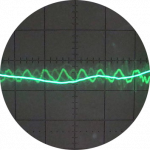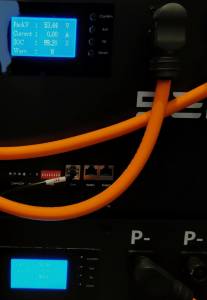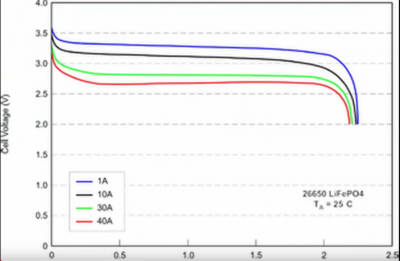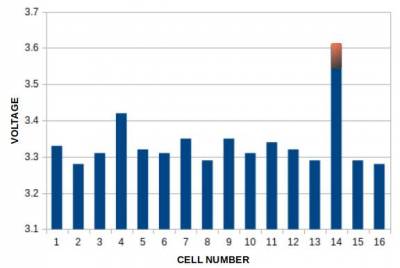Posted by: @vaugiThere is a special offer I received at £2340+VAT on this, so I might be tempted to get that.
Let me just clarify @vaugi
You need to be certain that the inverter made by Deye and badged Turbo Energy has
- G98 certification
- is on the ENA database in respect of its export capabilities (G99 with attached storage)
Just because the SunSynk version/derivative of this product has the relevant certification for grid-tied operation in the UK does not mean that the approval also applies to similar products from the same manufacturing source.
Crucial differences might be present within the internal firmware, particularly in the way it behaves under fault conditions.
Certification costs time and money. That alone might account for the increased cost of Sunsynk inverters in the UK.
In this case you have identified ITS as the UK-based supplier.
They already sell Sunsynk inverters.
They are a well known supplier to professional installers and should be able to produce the required documents for you to verify.
In addition, you do not need to wait until you are ready to install before obtaining permission from your DNO.
Nor does that consent have to be sought by a registered installer or electrician. You can undertake this yourself.
Simply go to the website for your DNO and look for the ENA forms to apply for grid-connection.
Complete the sections which identify the products you intend to buy, and submit the form.
The DNO Application is free, and you will receive a swift response if the inverter-based system is on the Approved database.
Equally, the response will identify any possible constraints that the DNO requires to be addressed.
The application process checks the supply/feed between your site and your 11kV substation.
That allows them to assess whether there is sufficient capacity on the cable and whether reinforcement works are required.
Save energy... recycle electrons!
Posted by: @transparentLet me just clarify @vaugi
You need to be certain that the inverter made by Deye and badged Turbo Energy has
Just because the SunSynk version/derivative of this product has the relevant certification for grid-tied operation in the UK does not mean that the approval also applies to similar products from the same manufacturing source.
Good point, I assumed (wrongly) that as ITS being a UK supplier was selling them, that they would be certified for the UK market. Indeed, they do say this but that doesn't really cover it I assume?
"Turbo Hybrid uses Sunsynk hardware and so for G99 application Sunsynk inverter should be used."
The problem with Sunsynk appears to be that they don't have any 3 phase in the country, and no sign of any leadtimes. Sunsynk do seem to have put a lot more effort and resource in, worth it over and above buying a Deye from China.
We've installed the 5kW Sunsynk now, and I've been playing with the Seplos Mason box.
After installing the Seplos 280Ah box the setup manual has a brief section about "capacity learning" but is scant on detail...how did you go about doing this?
Using the battery monitor I changed the total and rated capacity to 280ah. I had to also manually change the "SOC" to make it so the Sunsynk didn't think it was already at 100%. I then charged at 100A until the pack stopped, supposedly around 97% SOC. First it went through a "monomer cell over volt warning" but carried on charging at a lower charge, then stopped with a "total pressure warning". At this point cell difference was about 188mV I think, so one was quite a bit lower, supposedly around 97% SOC.
I then tried to discharge the pack to 0% by setting the inverter to 0% alarms, I also changed the "Remaining capacity warning" to 5% as it was stopping the inverter discharging at 15% otherwise. It discharged until around 26% SOC where it stopped with a "total pressure warning" with the lowest cell being 2.9v but most others being over 3v.
I did top balance the cells to 3.6v before putting them in, but it was about 2-3 weeks until I could finalise the battery - could I have damaged them by leaving them? I read that the cell voltaes can be a bit erratic for a few cycles, so could balance closer over time...or am I going to have to pull them out and try another top balance?
I'll probably be sticking with a 15-90% cycle as at the moment I have plenty of capacity for the house in that range, I'm just trying to get it to learn the capacity for now.
Good to hear of progress @vaugi
Are you aware that Sunsynk have a public forum where you can raise particular issues about their products?
I don't understand your comment about them not having a 3-phase inverter in the UK.
I've just checked the Electrical Network Association's Type-Test Register, and there's approval for Sunsynk's export-limitation system on 3-phase supplies dated Feb 2020.
That's the crucial part of having passed G98 certification. So if you enter the model number of a particular Sunsynk 3-ph inverter of interest, then you should also find it listed.
If there are still doubts about this, then please contact Tom Cunliffe, who is their UK Manager, and invite him to respond directly here on this forum. He'd be very welcome. 🙂
Seplos Mason box.
A. You will not have caused any 'damage' to the LiFePO4 cells by leaving them a few weeks after top-balancing.
Quite the contrary... it's good practice to let the cells rest before trying to discharge and recharge them in a 'live' system.
I always wait at least a week after top-balancing before connecting up the cells to an inverter.
B. The cell difference of 188mV is unlikely to have been taken into account when the Seplos BMS gave the "monomer cell over voltage" warning.
It's flagging up that one cell in the pack has reached the set threshold (per cell), as opposed to the entire battery having reached its max voltage.
Ie you shouldn't persist in charging the pack because you risk damage to that cell.
Let the battery rest overnight and check that cell again.
It may have settled back, in which case the "cell over-voltage" could have been caused only because you elected to use such a high charge current.
(It won't have settled due to the BMS balancing, because that should only be functional when it's actually charging.)
C. The BMS should be configured so that the battery parameters are outside (beyond) those you've set on the inverter.
In normal operation, the BMS should then never generate an alarm.
It's intended to be your last line of defence.
D. I don't know how the SoC is arrived at for either the Seplos BMS or the Sunsynk inverter.
It is by far the most difficult parameter for these devices to accurately report.
Both Victron and Batrium have put considerable effort into designing coulomb-counting systems to obtain accurate SoC figures.
Their high costs reflect how much effort has been put into those respective R&D projects.
Keep raising these points here on the Forum.
These are just the sort of issues which need more widespread discussion.
Save energy... recycle electrons!
@vaugi I believe it's covered by Andy here -
Basically you have to charge the crap out of it, then it'll set. Personally I set the capacity to 400ah and let it charge until the alarms stopped it. Then I set it back to 280ah as I knew it would be at 100% SOC in that stage.
What I like to see on a sunny day. 30kwh of storage fully charged by the early afternoon. £10 worth as 34p/kwh
That looks good @batalto
I'm going to expand on the above photo for the sake of others who will read this topic in future.
Here's the curve of voltage/capacity for a typical LiFePO4 cell, such as those being used in the Seplos Mason box.
Those coloured lines are produced by dis-charging the cell at the stated current over a period of time.
The upper (blue) one is of interest to us here, because it reflects the voltage when there's negligible current being drawn.
In his photo, Batalto's LCD screens are showing 53.4v for the top battery.
Dividing by the number of cells gives us the volts per cell: 53.4 / 16 = 3.34v ish
From my graph you'll see that this is just into the upturn of the curves.
It's not as high as each cell can technically be charged, which is more like 3.6v
But it's what @batalto has set as the upper charge limit... ie leaving a margin of safety.
That upturn in the voltage curve is easily detectable by the Battery Management System (BMS) within the Mason box.
It's a good target to aim for.
Returning to the photo, the State of Charge (SOC) is reading 99.2%
Once again that is based on @batalto's configuration in which 53.4v is regarded as "Full", or 100%
Save energy... recycle electrons!
@transparent it's the default set in the BMS. For my needs it's fine. The batteries are basically full at that point anyway and my depth of discharge is 90%
That's a reasonable default setting for the max voltage.
Do you know if the BMS assesses it by measuring the volts across the main power connections to the battery, or by adding up the voltage for each of the 16 cells?
The difference may not, at first, appear obvious.
Let me insert another graphical explanation...
Here the total battery voltage is 53.4v...
... but one cell has gone beyond 3.6v and the BMS should really be taking action to prevent damage to it.
A sensible solution would be for the BMS to send a command to the inverter/charger when the first cell reaches 3.5v, requesting that the charge current be reduced.
That would allow the BMS more time to use its cell-balancing function and hence allow a more even charging regime.
Alas, such communication between BMS and inverter is very rare.
Most connected BMS units simply pass data which can be displayed on the inverter's LCD 😣
Save energy... recycle electrons!
@transparent it measures each cell. I can check each one individually. From my understanding balancing kicks in when the cells are more than 115mv in difference. But it's a rubbish balancer
Posted by: @transparentGood to hear of progress @vaugi
Are you aware that Sunsynk have a public forum where you can raise particular issues about their products?
I don't understand your comment about them not having a 3-phase inverter in the UK.
I've just checked the Electrical Network Association's Type-Test Register, and there's approval for Sunsynk's export-limitation system on 3-phase supplies dated Feb 2020.
I should have been clearer, sorry. Yes, I was aware there exists 3 phase inverters from Sunsynk (8/10/12kW) but finding any in stock was the problem, some resellers couldn't even give me a leadtime. I went back to my original source, CEF, who I have an account with, and it turns out they have bought out Segen so have good access to Sunsynk now I think, and I can order for 3 day delivery.
I was looking at getting a Sunsynk 12kW (trying to max out!) however looking at the spec sheet I wonder if that's not a great match for parallel Seplos boxes - the Sunsynk 12kW max charge/discharge rate is 240A, and the Seplos Mason is 200A BMS. So, perhaps I drop down to the 10kW version.
Posted by: @transparentSeplos Mason box.
A. You will not have caused any 'damage' to the LiFePO4 cells by leaving them a few weeks after top-balancing.
Quite the contrary... it's good practice to let the cells rest before trying to discharge and recharge them in a 'live' system.
I always wait at least a week after top-balancing before connecting up the cells to an inverter.
Great to know, that's a relief, so thanks for clarifying on that.
Posted by: @transparentB. The cell difference of 188mV is unlikely to have been taken into account when the Seplos BMS gave the "monomer cell over voltage" warning.
It's flagging up that one cell in the pack has reached the set threshold (per cell), as opposed to the entire battery having reached its max voltage.
Ie you shouldn't persist in charging the pack because you risk damage to that cell.Let the battery rest overnight and check that cell again.
It may have settled back, in which case the "cell over-voltage" could have been caused only because you elected to use such a high charge current.
(It won't have settled due to the BMS balancing, because that should only be functional when it's actually charging.)C. The BMS should be configured so that the battery parameters are outside (beyond) those you've set on the inverter.
In normal operation, the BMS should then never generate an alarm.
It's intended to be your last line of defence.
Yes, I can see that having played around with the settings a bit now. I contacted Seplos technical support, and received a very short document back that really didn't help, confused me a bit more, but in the chat they gave me an important point - to set the Inverter to a lead acid/AGM setting so that it doesn't try to work off the SOC%, but allows the BMS to stop and start charging discharging based on it's own parameters.
I did this, and then I changed a few of the top and low end cell parameters to make the pack charge higher and lower for a single charge and discharge - for example over voltage warning at 3.5v, cut off at 3.6v. Undervoltage warning at 2.9v and 2.7v. I calculated the total over volt and under volt and put that in as well (e.g. 3.6x16=57.6v). I expected that the pack would show a warning when one cell was at 3.5v but continue to charge until one was at 3.6v but I *think* it stopped charging at 3.5v. I don't know for sure, I did some try some logging but not it's not obvious so can't be sure.
However, I'm fairly happy with it now - I've set my inverter back to Lithium setting and now charge to 95% and down to 20%. Perhaps a bit cautious but we are typically using around 10-11kWh per day using TOU. From calculating the kWh output and the SOC% it does seem to be giving a pack capacity of around 14.5kWh which seems about right. I haven't yet reset the low and high voltage warnings and cut offs as unsure what range is ideal, but effectively the Inverter is stopping short at either end anyway due to the 95/20 settings. (I take your point that SOC% might not be accurate!
I haven't caught what the cell voltage differences might be now at the top and bottom SOC, it's been running for a week or so, I should probably try to get the battery monitor to log it and see. Generally when I go and have a peak (not internet connected yet as it's in a detached garage 15m from house...) the cell diff is around 2-4mv, and now I've learnt from your plots that it's not hugely helpful, but at least it's close rather than far apart.
@transparent any recommendation on grid tied hybrid inverters? I need one with CT clamps as my current one isn't for my solar, only for controlling my batteries. They aren't linked currently, so sometimes I have an issue with one discharging to charge the other as they don't realise.
- 26 Forums
- 2,356 Topics
- 53.4 K Posts
- 216 Online
- 6,017 Members
Join Us!
Worth Watching
Latest Posts
-
RE: Who's your electricity provider and what's your tariff?
I agree, the consumer is not being properly represented...
By Batpred , 2 minutes ago
-

RE: External pipework insulation
Thank you @david-s. Just for context, if anyone has que...
By Mars , 3 minutes ago
-

RE: Controlling Daikin Altherma via P1P2 and Home Assistant
@weoleyric, apologies for the delay in response. Give...
By Majordennisbloodnok , 2 hours ago
-
RE: Octopus Cosy Heat Pump Owners & Discussion Thread
@harrisonc wow. That’s going to get the rumour mill gr...
By AndrewJ , 4 hours ago
-
RE: Advice on internal circulation pump noise
Thanks @mikefl - I'll maybe have a look at the lock-shi...
By jtg , 17 hours ago
-

RE: Heat Pump Heats the House… But It’s Not Cosy. Emitter Changes or System Tweak?
@toodles interesting suggestion, thanks. I will try to...
By GrahamF , 17 hours ago
-
RE: Mitsubishi Ecodan Auto Adaption trial to stop cycling.
The interval you talk of, i think, will be 60min for an...
By F1p , 21 hours ago
-

RE: Electricity price predictions
Does anyone have a current graphic, visual or breakdown...
By Mars , 1 day ago
-
Agree with @majordennisbloodnok on the setbacks. We hav...
By ChandyKris , 2 days ago
-
RE: New Fogstar 15.5kWh upright solution
It is a matter of luck. 2ith Fogstar "instructions", to...
By Batpred , 2 days ago
-

RE: Speedcomfort radiator fans
@deltona the way the links were added broke the page. A...
By Mars , 2 days ago
-

RE: Setback savings - fact or fiction?
I agree! Even more so if we get an answer! But the chal...
By cathodeRay , 2 days ago
-

RE: Refrigerant R32, is it now banned in the EU from 1st Jan 2027 for monobloc ASHPs?
This has been delayed from what I believe to be this ye...
By dgclimatecontrol , 2 days ago
-
RE: Are We Sleepwalking Into Another Race to the Bottom?
this is why I provided current flow temperatures in the...
By ksim , 2 days ago
-

RE: Why Millions of UK Homes Struggle With Heat Pumps
There's many homes that would be quite a disruption for...
By dgclimatecontrol , 2 days ago
-
RE: Ecodan unable to hit legionella target temp - what's the consensus?
@rhh2348 ...maybe this option is what you want? Alter...
By benson , 2 days ago
-

RE: Free Ecoheat Heat Pump Install
@old_scientist This does make the unit smaller as the b...
By dgclimatecontrol , 2 days ago
-
RE: Ecodan - Legionella Operation Time and Target Temperature
@old_scientist hiya mate, did you ever get to the botto...
By 9jwr9 , 2 days ago








